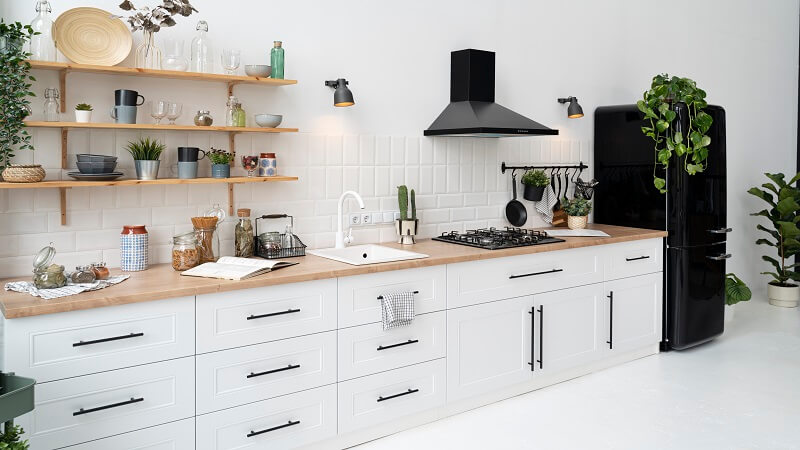Renovating a kitchen can be an exciting project that transforms the heart of your home, but it also requires careful planning and practical considerations. A kitchen renovation isn’t just about choosing the latest appliances or trendy colors—it’s about ensuring that the space functions well for your needs and lasts for years to come. Below are ten key factors to consider to help guide you through the process of renovating your kitchen.
1. Set a Realistic Budget
The first and most important step in any kitchen renovation is to establish a budget. Without a clear financial plan, costs can quickly spiral out of control. Be sure to allocate funds not only for major expenses such as cabinetry and countertops but also for hidden costs like labor, permits, and unexpected issues that may arise during construction.
Tips for Setting a Budget:
- Create a list of essential elements you cannot compromise on.
- Allow for a contingency of about 10-20% for unexpected costs.
- Consider how much value the renovation will add to your home, especially if you plan to sell in the future.
2. Plan the Layout Carefully
The kitchen layout is crucial to the functionality of the space. Whether you’re working with a small kitchen or a larger area, planning the workflow and placement of essential elements—such as the sink, stove, and refrigerator—is vital. This layout concept is often referred to as the “kitchen work triangle.”
Important Layout Considerations:
- Ensure there’s enough space between the sink, stove, and fridge for smooth movement.
- Make sure countertops are close to these main areas for easy prep work.
- Think about where you’ll store items and how easy they are to access.
3. Choose Durable Materials
Kitchens endure a lot of wear and tear, so choosing durable materials is essential. While it might be tempting to go for the most aesthetically pleasing option, durability should come first. Materials like quartz or granite for countertops, hardwood or tile for flooring, and solid wood or high-quality MDF for cabinets will ensure your kitchen stands the test of time.
Best Material Choices:
- Countertops: Quartz, granite, or butcher block.
- Cabinets: Solid wood or MDF with a laminate finish for durability.
- Flooring: Hardwood, ceramic tile, or vinyl plank.
4. Focus on Storage Solutions
Ample storage is a must in a well-designed kitchen. Without enough cabinets, drawers, and shelving, your kitchen can quickly become cluttered. Consider innovative storage solutions that make the most of every inch of space. Pull-out shelves, lazy Susans, and vertical storage racks can make a big difference.
Creative Storage Ideas:
- Install deep drawers for pots and pans.
- Use pull-out shelves for easier access to items in the back.
- Incorporate vertical shelving for spices, oils, or baking trays.
5. Think About Lighting
Good lighting is crucial in a kitchen, both for safety and aesthetics. You’ll need a combination of task lighting for food preparation areas, ambient lighting for overall brightness, and accent lighting for aesthetic appeal. Don’t forget about under-cabinet lighting, which can be both functional and visually appealing.
Types of Lighting:
- Task Lighting: Bright lights placed over work areas such as countertops or the stove.
- Ambient Lighting: General overhead lighting, often in the form of recessed lights or a central fixture.
- Accent Lighting: Lights that highlight certain features, such as a decorative backsplash or kitchen island.
6. Select Energy-Efficient Appliances
Investing in energy-efficient appliances will not only help reduce your kitchen’s environmental footprint but also lower your energy bills in the long run. When choosing appliances, look for models with an ENERGY STAR label, which indicates that they meet high standards for energy efficiency.
Key Appliance Considerations:
- Refrigerator: Look for models with a good energy efficiency rating.
- Dishwasher: Newer models often use less water and energy.
- Oven/Stove: Induction cooktops are more energy-efficient than traditional electric or gas ranges.
7. Prioritize Ventilation
A kitchen is often the busiest room in the house, so proper ventilation is essential to maintain good air quality. Good ventilation prevents cooking smells, grease, and moisture from accumulating. A quality range hood is a good investment to improve air circulation and keep your kitchen smelling fresh.
Types of Kitchen Ventilation:
- Range Hoods: Choose between ducted (vents to the outside) and non-ducted (recirculates air) hoods.
- Windows: If possible, add or improve windows to allow for natural ventilation.
- Exhaust Fans: Install an exhaust fan to help remove steam and heat.
8. Don’t Forget the Backsplash
While often overlooked, a backsplash can be both functional and stylish. It protects your walls from food splatter, grease, and water while adding a visual focal point to your kitchen. Choose materials that are easy to clean, such as ceramic tiles or glass.
Backsplash Materials to Consider:
- Tile: Durable and easy to clean.
- Glass: Sleek and modern, but requires more cleaning.
- Stone: Adds a rustic touch but can be more challenging to maintain.
9. Pay Attention to Plumbing and Electrical Work
Renovating a kitchen often involves moving or adding plumbing and electrical fixtures. If you’re planning to relocate major elements like the sink or oven, you’ll need to factor in the cost of rerouting pipes and electrical lines. It’s important to hire licensed professionals to ensure the work is done correctly and to code.
Plumbing and Electrical Considerations:
- Relocating water lines for sinks and dishwashers may require significant work.
- Make sure electrical outlets are conveniently placed for small appliances.
- If adding new appliances, ensure your home’s electrical panel can handle the additional load.
10. Personalize with Finishing Touches
Once the major components are in place, it’s time to add your personal touch to the kitchen. This could be through your choice of hardware, paint colors, or decorative items like plants or artwork. These details can make your kitchen feel more inviting and cohesive with the rest of your home.
Finishing Touches Ideas:
- Choose hardware that complements your cabinetry.
- Add rugs, curtains, or plants to create warmth and texture.
- Hang artwork or family photos to personalize the space.
Conclusion
A successful kitchen renovation requires careful planning and attention to detail. By considering practical factors like budget, layout, materials, and storage, you can create a kitchen that is both functional and stylish. Each decision, from selecting durable countertops to investing in energy-efficient appliances, contributes to the longevity and enjoyment of your kitchen space.

